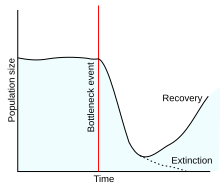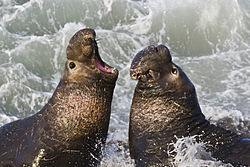
Inbreeding is the production of offspring from the mating or breeding of individuals or organisms that are closely related genetically. By analogy, the term is used in human reproduction, but more commonly refers to the genetic disorders and other consequences that may arise from expression of deleterious recessive traits resulting from incestuous sexual relationships and consanguinity. Animals avoid incest only rarely.
Small populations can behave differently from larger populations. They are often the result of population bottlenecks from larger populations, leading to loss of heterozygosity and reduced genetic diversity and loss or fixation of alleles and shifts in allele frequencies. A small population is then more susceptible to demographic and genetic stochastic events, which can impact the long-term survival of the population. Therefore, small populations are often considered at risk of endangerment or extinction, and are often of conservation concern.
Population genetics is a subfield of genetics that deals with genetic differences within and among populations, and is a part of evolutionary biology. Studies in this branch of biology examine such phenomena as adaptation, speciation, and population structure.
Phylogeography is the study of the historical processes that may be responsible for the past to present geographic distributions of genealogical lineages. This is accomplished by considering the geographic distribution of individuals in light of genetics, particularly population genetics.

In population genetics, gene flow is the transfer of genetic material from one population to another. If the rate of gene flow is high enough, then two populations will have equivalent allele frequencies and therefore can be considered a single effective population. It has been shown that it takes only "one migrant per generation" to prevent populations from diverging due to drift. Populations can diverge due to selection even when they are exchanging alleles, if the selection pressure is strong enough. Gene flow is an important mechanism for transferring genetic diversity among populations. Migrants change the distribution of genetic diversity among populations, by modifying allele frequencies. High rates of gene flow can reduce the genetic differentiation between the two groups, increasing homogeneity. For this reason, gene flow has been thought to constrain speciation and prevent range expansion by combining the gene pools of the groups, thus preventing the development of differences in genetic variation that would have led to differentiation and adaptation. In some cases dispersal resulting in gene flow may also result in the addition of novel genetic variants under positive selection to the gene pool of a species or population

In population genetics, the founder effect is the loss of genetic variation that occurs when a new population is established by a very small number of individuals from a larger population. It was first fully outlined by Ernst Mayr in 1942, using existing theoretical work by those such as Sewall Wright. As a result of the loss of genetic variation, the new population may be distinctively different, both genotypically and phenotypically, from the parent population from which it is derived. In extreme cases, the founder effect is thought to lead to the speciation and subsequent evolution of new species.

Genetic diversity is the total number of genetic characteristics in the genetic makeup of a species, it ranges widely from the number of species to differences within species and can be attributed to the span of survival for a species. It is distinguished from genetic variability, which describes the tendency of genetic characteristics to vary.

Argyroxiphium is a small genus of plants in the family Asteraceae. Its members are known by the common names silversword or greensword due to their long, narrow leaves and the silvery hairs on some species. The silverswords belong to a larger radiation of over 50 species, including the physically different genera Dubautia and Wilkesia. This grouping is often referred to as the silversword alliance. Botanist P. H. Raven referred to this radiation as "the best example of adaptive radiation in plants".
In population genetics and population ecology, population size is a countable quantity representing the number of individual organisms in a population. Population size is directly associated with amount of genetic drift, and is the underlying cause of effects like population bottlenecks and the founder effect. Genetic drift is the major source of decrease of genetic diversity within populations which drives fixation and can potentially lead to speciation events.

Conservation genetics is an interdisciplinary subfield of population genetics that aims to understand the dynamics of genes in a population for the purpose of natural resource management, conservation of genetic diversity, and the prevention of species extinction. Scientists involved in conservation genetics come from a variety of fields including population genetics, research in natural resource management, molecular ecology, molecular biology, evolutionary biology, and systematics. The genetic diversity within species is one of the three fundamental components of biodiversity, so it is an important consideration in the wider field of conservation biology.
Genetic viability is the ability of the genes present to allow a cell, organism or population to survive and reproduce. The term is generally used to mean the chance or ability of a population to avoid the problems of inbreeding. Less commonly genetic viability can also be used in respect to a single cell or on an individual level.

Molecular ecology is a field of evolutionary biology that is concerned with applying molecular population genetics, molecular phylogenetics, and more recently genomics to traditional ecological questions. It is virtually synonymous with the field of "Ecological Genetics" as pioneered by Theodosius Dobzhansky, E. B. Ford, Godfrey M. Hewitt, and others. These fields are united in their attempt to study genetic-based questions "out in the field" as opposed to the laboratory. Molecular ecology is related to the field of conservation genetics.
Inbreeding depression is the reduced biological fitness that has the potential to result from inbreeding. The loss of genetic diversity that is seen due to inbreeding, results from small population size. Biological fitness refers to an organism's ability to survive and perpetuate its genetic material. Inbreeding depression is often the result of a population bottleneck. In general, the higher the genetic variation or gene pool within a breeding population, the less likely it is to suffer from inbreeding depression, though inbreeding and outbreeding depression can simultaneously occur.

Human genetic variation is the genetic differences in and among populations. There may be multiple variants of any given gene in the human population (alleles), a situation called polymorphism.

Masatoshi Nei was a Japanese-born American evolutionary biologist.
A genetic isolate is a population of organisms with little genetic mixing with other organisms within the same species due to geographic isolation or other factors that prevent reproduction. Genetic isolates form new species through an evolutionary process known as speciation. All modern species diversity is a product of genetic isolates and evolution.

In biology, evolution is the process of change in all forms of life over generations, and evolutionary biology is the study of how evolution occurs. Biological populations evolve through genetic changes that correspond to changes in the organisms' observable traits. Genetic changes include mutations, which are caused by damage or replication errors in organisms' DNA. As the genetic variation of a population drifts randomly over generations, natural selection gradually leads traits to become more or less common based on the relative reproductive success of organisms with those traits.
Genetic monitoring is the use of molecular markers to (i) identify individuals, species or populations, or (ii) to quantify changes in population genetic metrics over time. Genetic monitoring can thus be used to detect changes in species abundance and/or diversity, and has become an important tool in both conservation and livestock management. The types of molecular markers used to monitor populations are most commonly mitochondrial, microsatellites or single-nucleotide polymorphisms (SNPs), while earlier studies also used allozyme data. Species gene diversity is also recognized as an important biodiversity metric for implementation of the Convention on Biological Diversity.

Argyroxiphium sandwicense subsp. sandwicense, the Mauna Kea silversword, is a highly endangered flowering plant endemic to the island of Hawaiʻi of Hawaii. It is the "crown jewel" of the volcanic mountain Mauna Kea, from which it derives its English name. The Hawaiian name is ʻahinahina; it applies to silverswords more broadly. The Mauna Kea silversword was once common on the volcano, and extraordinary conservation efforts are being made to preserve the species.
Genetic rescue is seen as a mitigation strategy designed to restore genetic diversity and reduce extinction risks in small, isolated and frequently inbred populations. It is largely implemented through translocation, a type of demographic rescue and technical migration that adds individuals to a population to prevent its potential extinction. This demographic rescue may be similar to genetic rescue, as each increase population size and/or fitness. This overlap in meaning has led some researchers to consider a more detailed definition for each type of rescue that details 'assessment and documentation of pre- and post-translocation genetic ancestry'. Not every example of genetic rescue is clearly successful and the current definition of genetic rescue does not mandate that the process result in a 'successful' outcome. Despite an ambiguous definition, genetic rescue is viewed positively, with many perceived successes.











